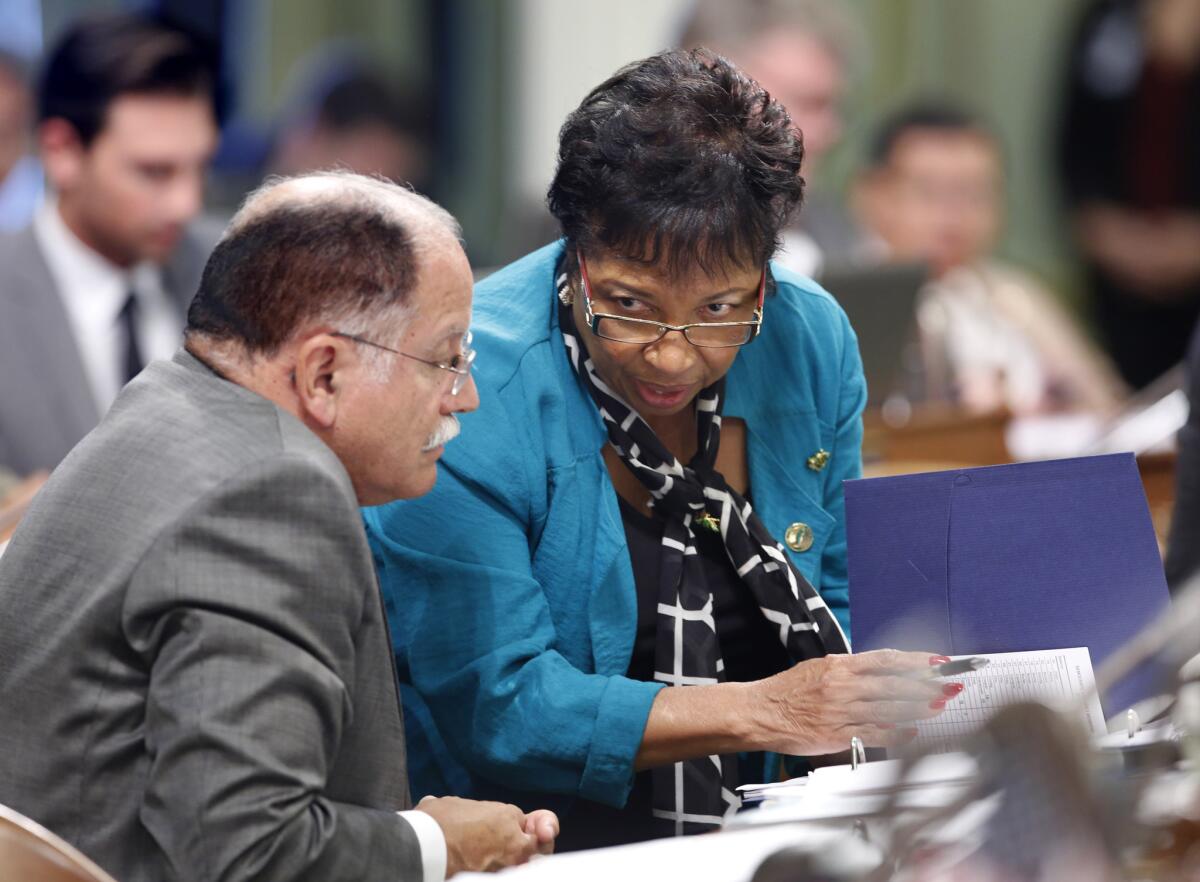Editorial: Big money overwhelms a small SoCal Assembly race

Assemblywoman Cheryl Brown, D-San Bernardino, talks with Assemblyman Jose Medina, D-Riverside on Feb. 24, 2016. Brown faces an unexpected challenge from the left this year as political fallout for her moderate votes.
The working-class communities in the 47th Assembly district are some of the most economically disadvantaged in Southern California. The largest city in this district, San Bernardino, is still reeling from bankruptcy, with an unemployment rate of 7.2%, compared with 5.4% statewide. The district’s residents are suffering too from some of the worst air pollution in the nation, a result of geography — the 47th backs up against the mountains where the dirty air collects — and the industrial history of a region built by railroads and Kaiser Steel.
The big political forces battling over the Assembly seat don’t seem to care about the district’s unique needs, however. They want someone who will reliably side with them on their issues, regardless of how they might affect his or her constituents.
The amount of money dropped on this race so far is astonishing, given the two top candidates in the June 7 primary are Democrats who will likely face each other again in the November general election. About $2.3 million has been reported in campaign donations and independent expenditures, almost all of that supporting the reelection of incumbent Cheryl Brown (D-San Bernardino), an increasingly rare business-friendly Democrat facing a strong challenge from another Democrat, workers compensation attorney Eloise Gomez Reyes.
An astonishing amount of money has been dropped on this race given the two candidates are democrats who will likely face each other again in the November general election.
Nearly half of that money has come from Chevron, which has spent $1 million to promote Brown’s re-election independently though there are no oil refineries in her district. The “Keeping Californians Working, Dentists, Housing Providers, Energy and Insurance Agents” independent expenditure committee has also received large contributions from the California Apartment Association ($250,000) and the California Dental Association ($500,000). The committee has paid for at least two campaign mailers on behalf of Brown.
That’s a lot of money even in California, where it typically takes about $1 million to win even a low-key legislative race. But don’t feel sorry for Reyes. Though with only about $160,000 in contributions reported so far, she also has big political guns on her side. They include the United Food and Commercial Workers, which contributes heavily to legislative races and policy fights, and the Sierra Club. Both organizations have been using their considerable resources to help Reyes beat Brown. Rallies have been held to call out Brown’s anti-environmental votes and financial support from oil companies.
Why are some of the state’s biggest special interests so invested in one little legislative seat out of 120? Here’s a hint: Brown was one of the so-called moderate Democrats who last year stalled a landmark global warming bill, SB 350. At issue was a proposed requirement that fossil-fuel use be cut 50% by 2030. The oil lobby dropped millions of dollars fighting that provision, which was eventually stripped out thanks to Assembly members like Brown.
She defended her position by saying she worried that the cost of fuel would have a disproportionate affect on her constituents, many of whom can’t afford fuel-efficient vehicles and live in communities without reliable public transportation. However pure Brown’s intentions might have been, her message has been eclipsed by the facts that she’s received many thousands of dollars in campaign donations from the oil industry in the past, and that Chevron is willing to spend $1 million to make sure she gets re-elected.
It’s lamentable that big-monied interests overwhelm local ones, but it’s become increasingly common since the Supreme Court tossed the reins on independent spending by corporations and unions. So where does this leave voters? Is Brown looking out for their interests, or her own? Or is she a true independent, targeted by the progressive Democratic establishment still mad about her vote on SB 350 and other party-line bills? Will Reyes be more than a shill for labor and environmental interests in Sacramento? If she wins this race, she will know first hand what bucking your party can get you.
It will be hard work for voters to know what’s in their best interests when the vast majority of the messages they are hearing don’t come from the candidates, but from corporations and organizations with their own agenda. Good luck to them all.
Follow the Opinion section on Twitter @latimesopinion and Facebook
More to Read
A cure for the common opinion
Get thought-provoking perspectives with our weekly newsletter.
You may occasionally receive promotional content from the Los Angeles Times.






